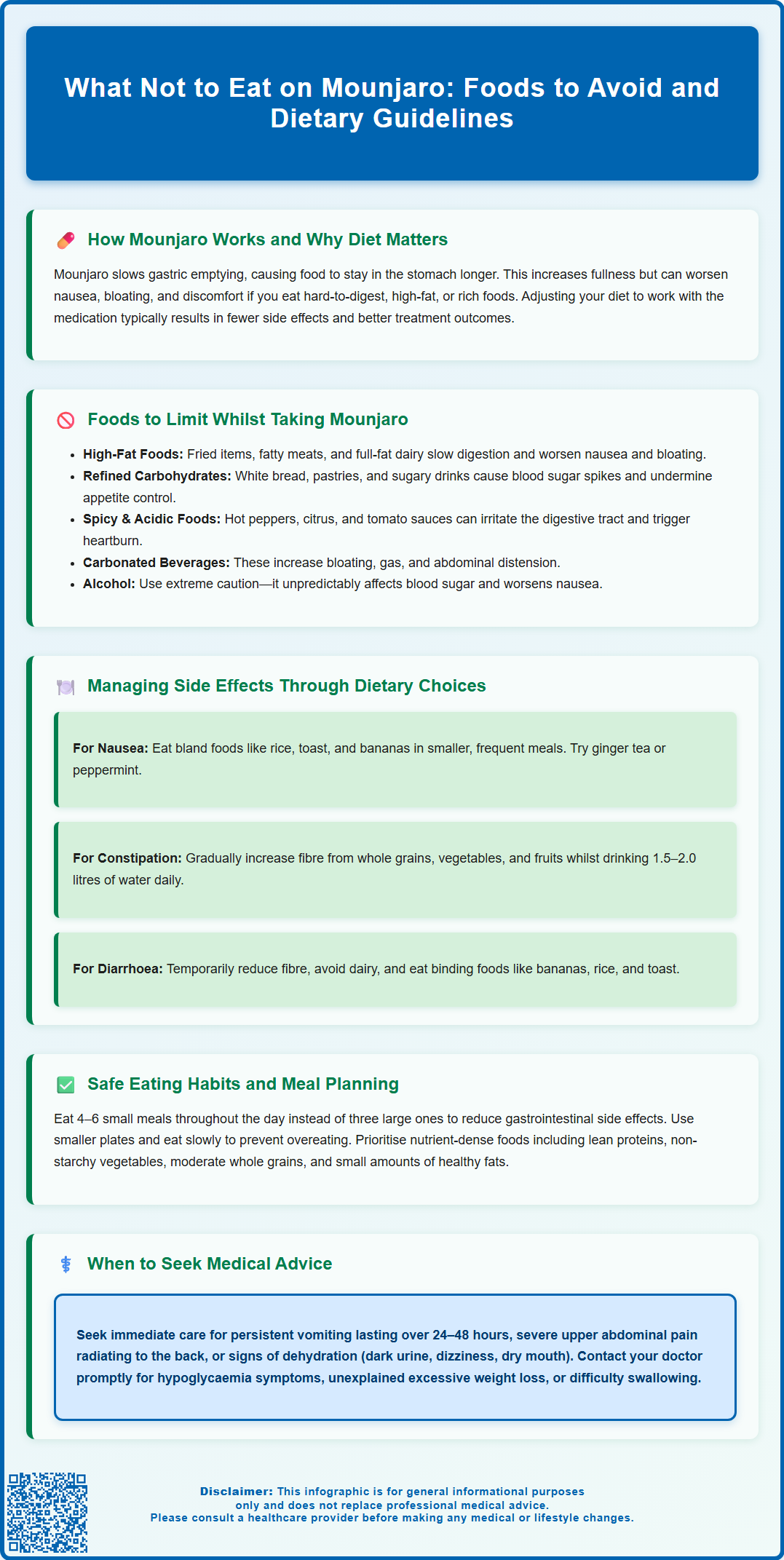Wegovy®
A weekly GLP-1 treatment proven to reduce hunger and support meaningful, long-term fat loss.
- ~16.9% average body weight loss
- Boosts metabolic & cardiovascular health
- Proven, long-established safety profile
- Weekly injection, easy to use

Mounjaro (tirzepatide) is a dual GIP and GLP-1 receptor agonist approved by the FDA for type 2 diabetes management. While no foods are strictly forbidden, understanding what not to eat on Mounjaro can significantly improve treatment tolerability and outcomes. The medication slows gastric emptying and reduces appetite, making certain foods more likely to trigger gastrointestinal side effects like nausea, bloating, and discomfort. Strategic dietary choices complement Mounjaro's mechanism, optimize blood glucose control, and minimize adverse effects. This guide provides evidence-based recommendations on foods to limit, practical meal planning strategies, and when to seek medical advice for diet-related concerns during Mounjaro therapy.
Summary: While taking Mounjaro, limit high-fat foods, refined carbohydrates, spicy or acidic foods, carbonated beverages, and alcohol to reduce gastrointestinal side effects and optimize blood glucose control.
Mounjaro (tirzepatide) is a dual glucose-dependent insulinotropic polypeptide (GIP) and glucagon-like peptide-1 (GLP-1) receptor agonist approved for the treatment of type 2 diabetes mellitus. By mimicking these naturally occurring incretin hormones, Mounjaro enhances insulin secretion in response to meals, suppresses glucagon release, and slows gastric emptying. This mechanism not only improves glycemic control but also promotes satiety and can lead to significant weight reduction.
The slowed gastric emptying is particularly relevant when considering dietary choices. Because food remains in the stomach longer, patients often experience prolonged fullness, reduced appetite, and altered tolerance to certain foods. This physiological change means that dietary habits directly influence both the medication's effectiveness and the patient's comfort level. Foods that are difficult to digest, high in fat, or excessively rich may exacerbate gastrointestinal side effects such as nausea, bloating, and abdominal discomfort.
Importantly, this delayed gastric emptying can temporarily reduce the absorption of oral medications, including oral contraceptives, especially during dose initiation or increases. Women using oral contraceptives should discuss additional contraceptive methods with their healthcare provider.
Understanding the relationship between Mounjaro's mechanism and diet is essential for optimizing treatment outcomes. While there are no absolute dietary restrictions mandated by the manufacturer, certain food choices can significantly impact tolerability and glycemic control. Patients who adapt their eating patterns to complement the medication's action typically report better adherence, fewer side effects, and improved overall satisfaction with treatment. Working collaboratively with healthcare providers to develop an individualized nutrition plan maximizes both safety and therapeutic benefit while supporting long-term metabolic health goals.
While taking Mounjaro, certain foods may worsen gastrointestinal side effects or interfere with optimal blood glucose management. High-fat foods are among the most problematic, as they require prolonged digestion and can intensify nausea, bloating, and delayed gastric emptying. Examples include fried foods, fatty cuts of meat, full-fat dairy products, heavy cream sauces, and processed foods high in saturated fats. These items may sit uncomfortably in the stomach and trigger or worsen common adverse effects.
Highly processed and refined carbohydrates should also be limited. Foods such as white bread, pastries, sugary cereals, candy, and sugar-sweetened beverages can cause rapid blood glucose spikes, counteracting Mounjaro's glycemic benefits. Additionally, these foods often lack nutritional value and may contribute to increased appetite once their effects wear off, undermining the medication's appetite-suppressing properties.
Spicy, acidic, and heavily seasoned foods may irritate the gastrointestinal tract, particularly when gastric emptying is already delayed. Hot peppers, citrus-heavy dishes, tomato-based sauces, and vinegar-rich foods can exacerbate heartburn, acid reflux, and stomach discomfort. Similarly, carbonated beverages may increase bloating and gas, adding to abdominal distension.
Alcohol consumption warrants particular caution. Alcohol can affect blood glucose levels unpredictably, increase the risk of hypoglycemia (especially when combined with insulin or sulfonylureas), and may worsen nausea and gastrointestinal upset. If consumed, alcohol should be limited and taken with food. Patients should discuss alcohol use with their healthcare provider to understand individual risk factors and receive personalized guidance on safe consumption limits.

Gastrointestinal side effects—including nausea, vomiting, diarrhea, constipation, and abdominal pain—are the most commonly reported adverse reactions to Mounjaro, particularly during dose initiation and escalation. Strategic dietary modifications can significantly reduce the severity and frequency of these symptoms, improving treatment tolerability and adherence.
To minimize nausea, patients should focus on bland, easily digestible foods such as plain rice, toast, crackers, bananas, applesauce, and boiled potatoes. Eating smaller, more frequent meals rather than three large meals helps prevent overwhelming the digestive system. Cold or room-temperature foods are often better tolerated than hot meals, as strong food odors can trigger nausea. Ginger tea, peppermint, and staying well-hydrated with clear fluids may provide additional relief.
For constipation management, increasing dietary fiber gradually is essential. Incorporate whole grains, vegetables, fruits with skin, legumes, and adequate fluid intake (typically 1.5-2.0 liters of water daily unless otherwise advised). However, introduce fiber slowly to avoid worsening bloating or gas. Conversely, if diarrhea occurs, a temporary reduction in fiber, avoidance of dairy products, and consumption of binding foods like bananas, rice, and toast may help. For persistent vomiting or diarrhea, oral rehydration solutions can help maintain electrolyte balance.
Protein-rich foods should be prioritized, as they promote satiety, support muscle maintenance during weight loss, and are generally well-tolerated. Lean poultry, fish, eggs, tofu, and legumes are excellent choices. Pairing protein with complex carbohydrates and non-starchy vegetables creates balanced meals that stabilize blood glucose and minimize gastrointestinal distress. Patients experiencing persistent or severe side effects despite dietary modifications should consult their healthcare provider, as dose adjustment or additional supportive measures may be necessary.
Establishing consistent, health-promoting eating habits is fundamental to successful Mounjaro therapy. Portion control becomes naturally easier due to the medication's appetite-suppressing effects, but conscious attention to portion sizes ensures adequate nutrition without overeating. Using smaller plates, measuring servings initially, and eating slowly while paying attention to satiety cues helps prevent discomfort and supports weight management goals.
Meal timing and frequency should be adjusted to individual tolerance. Many patients find that eating 4–6 small meals throughout the day, rather than three large ones, reduces gastrointestinal symptoms and maintains stable energy levels. Avoiding eating within 2–3 hours of bedtime can minimize nighttime reflux and nausea. Consistency in meal timing also helps regulate blood glucose patterns and allows patients to predict and manage their response to the medication.
Hydration is critically important but should be managed thoughtfully. While adequate fluid intake prevents constipation and supports overall health, drinking large volumes of liquid with meals may increase feelings of fullness to an uncomfortable degree. Sipping water throughout the day and limiting fluids during meals often works best. Avoid sugary drinks, and be mindful that caffeine may worsen gastrointestinal symptoms in some individuals.
When planning meals, emphasize nutrient density over calorie counting alone. Focus on:
Lean proteins: chicken breast, turkey, fish, eggs, Greek yogurt, legumes
Non-starchy vegetables: leafy greens, broccoli, cauliflower, peppers, zucchini
Whole grains: oats, quinoa, brown rice, whole wheat bread (in moderation)
Healthy fats in small amounts: avocado, nuts, seeds, olive oil
This approach ensures adequate micronutrient intake while supporting glycemic control and minimizing side effects. Consulting with a registered dietitian who specializes in diabetes management can provide personalized meal planning guidance tailored to individual preferences, cultural considerations, and medical needs.
While dietary adjustments can effectively manage many common side effects, certain symptoms require prompt medical evaluation. Persistent or severe nausea and vomiting that prevents adequate food or fluid intake, lasts more than 24–48 hours, or leads to signs of dehydration (dark urine, dizziness, dry mouth, decreased urination) necessitates immediate contact with a healthcare provider. Severe dehydration can lead to acute kidney injury, a recognized risk with GLP-1 receptor agonists.
Severe abdominal pain, particularly if persistent, localized to the upper abdomen, and radiating to the back, may indicate pancreatitis—a rare but serious adverse effect associated with Mounjaro. If pancreatitis is suspected, stop taking Mounjaro immediately and seek urgent medical care. This constitutes a medical emergency requiring immediate evaluation. Similarly, symptoms of gallbladder disease such as right upper quadrant pain, especially after eating fatty meals, warrant prompt assessment.
Patients experiencing unexplained weight loss exceeding expected therapeutic effects, difficulty swallowing, persistent heartburn unresponsive to dietary changes, or blood in vomit or stool should seek medical advice promptly. Additionally, signs of hypoglycemia—including shakiness, sweating, confusion, rapid heartbeat, or dizziness—particularly in patients taking Mounjaro alongside insulin or sulfonylureas, require immediate attention and possible medication adjustment.
Nutritional concerns also merit professional guidance. If dietary restrictions due to side effects become so limiting that nutritional adequacy is compromised, consultation with both the prescribing physician and a registered dietitian is essential. They can assess for potential deficiencies, recommend appropriate supplementation, and determine whether dose modification is appropriate. Regular follow-up appointments should include discussion of dietary tolerance, eating patterns, and any concerns about nutrition or side effects. Open communication with the healthcare team ensures that Mounjaro therapy remains both safe and effective while supporting overall health and quality of life.
If you experience side effects that you think might be related to Mounjaro, report them to your healthcare provider.
High-fat foods should be limited while taking Mounjaro as they require prolonged digestion and can intensify nausea, bloating, and gastrointestinal discomfort due to the medication's effect on gastric emptying. Examples include fried foods, fatty meats, full-fat dairy, and heavy cream sauces.
Alcohol should be consumed with caution on Mounjaro as it can cause unpredictable blood glucose changes, increase hypoglycemia risk (especially with insulin or sulfonylureas), and worsen gastrointestinal side effects. If consumed, limit intake and take with food, and discuss individual risks with your healthcare provider.
Bland, easily digestible foods such as plain rice, toast, crackers, bananas, and applesauce help reduce nausea from Mounjaro. Eating smaller, more frequent meals and choosing cold or room-temperature foods over hot meals can also improve tolerance and minimize gastrointestinal discomfort.
The health-related content published on this site is based on credible scientific sources and is periodically reviewed to ensure accuracy and relevance. Although we aim to reflect the most current medical knowledge, the material is meant for general education and awareness only.
The information on this site is not a substitute for professional medical advice. For any health concerns, please speak with a qualified medical professional. By using this information, you acknowledge responsibility for any decisions made and understand we are not liable for any consequences that may result.
Lorem ipsum dolor sit amet, consectetur adipiscing elit, sed do eiusmod tempor incididunt ut labore et dolore magna aliqua. Ut enim ad minim veniam, quis nostrud exercitation ullamco laboris nisi ut aliquip ex ea commodo consequat. Duis aute irure dolor in reprehenderit in voluptate velit esse cillum dolore eu fugiat nulla pariatur.
Block quote
Ordered list
Unordered list
Bold text
Emphasis
Superscript
Subscript